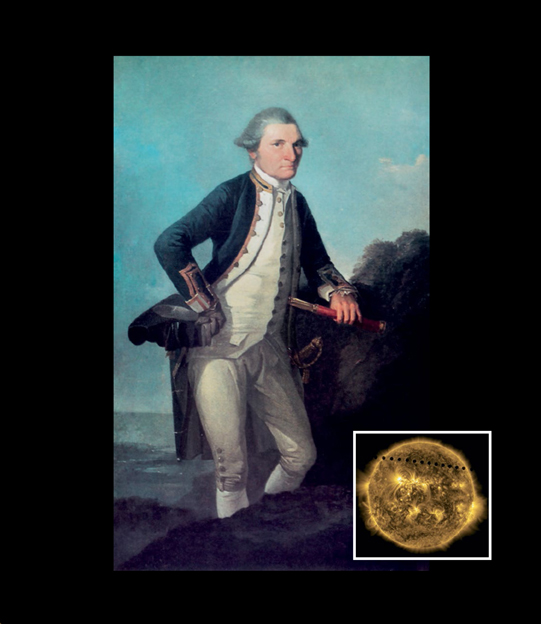1769
Transit of Venus
Captain James Cook (1728–1779)
The exploration of the so-called “new world” by European explorers in the sixteenth and seventeenth centuries was motivated by economics (the desire to find shorter and safer routes to the profitable Spice Islands in southeast Asia) as well as national glory (the conquest and settlement of new lands and the acquisition of new riches). It wasn’t until the eighteenth century that the desire to advance science or to learn more about the natural world became part of the motivation for voyages of exploration.
Among the first such voyages was the expedition of the British ship HMS Endeavour, commanded by Captain James Cook, to explore the Pacific and observe a rare transit (crossing) of the planet Venus across the disk of the Sun for the British Royal Society, one of the world’s oldest scientific organizations. Cook was sent to observe the 1769 transit from Tahiti, half a world away from Europe, so that the difference in perspective (parallax) and timing from such distant observations could help to determine the Astronomical Unit—the average distance between the Earth and the Sun.
Transits of Venus are rare, occurring only about once per century in pairs about eight years apart. Prior to Cook’s voyage, the previous pair of transits had occurred in 1631 and 1639, and only the latter was observed—and that only from a single site in England using a fairly crude early telescope. It was thought that Cook’s observations, and those of others using more modern instruments back in Europe and elsewhere, would significantly advance knowledge of the scale of the solar system as well as the size and nature of Venus.
The coordinated observations of the Venus transit of 1769 represented the world’s first large-scale international scientific collaboration. Despite ongoing wars and the hardships of long-distance travel, more than 120 observers at more than sixty separate observing sites around the world participated. The collective results of those observations established the Astronomical Unit to within about 1 percent of its modern accepted value (making this an amazingly accurate observation), and led to the widespread hypothesis that Venus might have a thick atmosphere like the Earth’s.
SEE ALSO The Spice Trade (c. 3000 BCE), First World Maps (c. 600 BCE), Circumnavigating the Globe (1519), Charting North America (1804), Natural Selection (1858–1859)
Main image: A 1776 portrait of Captain James Cook by British artist Nathaniel Dance-Holland. Inset: Time-lapse image from NASA’s Solar Dynamics Observatory satellite capturing the June 5, 2012 transit of Venus.
